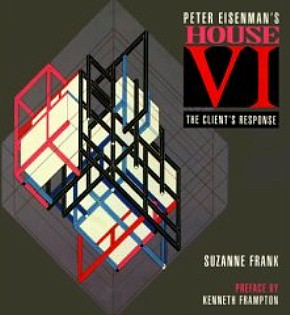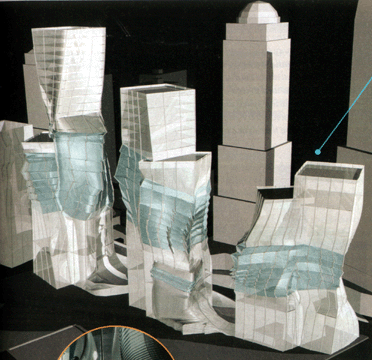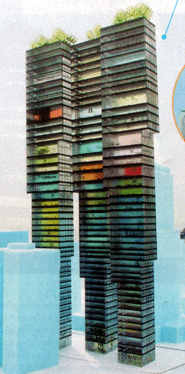2005.04.11 09:22
figure/ground vs field condition
Can you explain why the (so-called) extraordinarily rigid figure/ground relationship outside the Museum of Contemporary Art needed compensating? What about the temporary exhibit was non-rigid? (That's 'non-rigid' speaking figuratively, since the exhibit structure comprised many rigid components. The notion of non-hierarchical also seems a figurative notion, since a temporary condition by definition falls within a hierarchy.)
Exactly what classical figure/ground compositions does the City of Culture in Santiago de Compestela design-as-commentary dissolve? To me, the design looks more like the rethinking of a typical US suburban mall. Suburban malls are more a field condition than a figure/ground composition, aren't they?
Eisenman's Holocaust Memorial is probably more a traditional figure/ground condition inserted into a site-specific inserted field condition, rather than the other way around. Berlin since the end of WWII was/is hardly a 'traditional' place anymore.
If field conditions are somehow non-hierarchical, why do I get the feeling that field conditions are seen (at least by those that design them) as somehow better than figure/ground compositions?
2005.05.08 19:03
Re: clarification
First off, I accidentally skipped a paragraph within the passages I sent you earlier today. The missing paragraphs comes after "...Campo Marzio leads to the same conclusion." Here's the paragraph:
The obsessive articulation and deformation of the composition no longer correspond to an ars combinatoria. The clash of the geometric "monads" is no longer regulated by any "preestablished harmony"; and, most important, it demonstrates that the only meaning this paradoxical casuistry can refer back to is pure geometry, in the absolute semantic void that characterizes it.
It seems that Tafuri saw (in the Campo Marzio) individual plans that don't signify anything either historic or symbolic or even realistically typologic, and all together the Ichnographia is heap of meaningless fragments, thus it's all a divorce from any symbolic/meaningful system.
I just read some of Barthes' Elements of Semiology where a sign is composed of a signifier and a signified, and, what Tafuri sees is the Campo Marzio plans (individually and as a 'whole') as signs that still have a signifier, i.e., architectural building plans, but these signs/plans lack a signified, something that gives the plans any real meaning.
In reality, Piranesi employed all kinds of signs that carry a wide variety of signifiers--sometimes it's the shape of the plan(s), sometimes it's the placement/location (rightly or wrongly) of the plan(s), often it's just the label/name attached to the plan (which signify at least some historical existence), and then there are examples of combinations of the above distinctions, e.g., the Atrium Minerva (wisdom) as centerpiece of the 'garden of satire' which is situated at a location coincident with the top of the Spanish Steps, where Piranesi moved his family and business about a years after the Campo Marzio was published.
Anyway, there is so much out there now (especially from Eisenman) regarding this great analysis that Tafuri did, that this may be just the beginning of a great unraveling. Odd, I never imagined that reenactment would be at the center of all this.
In simple terms, Tafuri's work is unfortunately a history that was cooked too quickly, served too quickly, and eaten up too quickly.
| |
2005.11.08 15:23
It rocked Eisenman in his chair...
The following is part of an unexpected email I received about an hour ago:
"I am a student at the Yale Graduate school of Architecture. We have Eisenman as a professor and he makes us analyse, among others, Piranesi's Campo Marzio. Along with my own analysis, I used some of the more striking parts of your very interesting and excellent analysis. It rocked Eisenman on his chair and he is now inquiring into your analysis, of which he had not heard."
2005.11.15 13:17
Eisenman was rocked in his socks!
[Eisenman] mentions in "The Wicked Critic" (2000) that "This document [the Ichnographia], then, is a useful example for Tafuri for two principal reasons: first, in his montage of actual buildings, fantasy buildings, and buildings moved from their actual site..." It's worthwhile noting that no where does Tafuri ever mention that some buildings within the Ichnographia are moved from their actual site, yet within the Encyclopedia Ichnographica as published at www.quondam.com 1998-2000 there is much note of buildings within the Ichnographia that Piranesi moved from their actual site. Moreover, that Piranesi moved some buildings from their actual site is indeed part of the original material within the analysis of the Ichnographia at www.quondam.com.
2005.11.22 10:18
Your Ignorance is Inexcusable
"It is no accident that the New in the arts always announces itself in the guise of a revival, Hadid's career starts with the reinterpretation of Malevich's Teltonik, and her early work has indeed been (mis-)understood as neo-Constructivism. In a similar fashion, Peter Eisenman is said to take off from early Le Corbusier and Terragni. Revivalist appropriation is the easiest and most immediate option to articulate dissatisfaction and resistance towards a dominant practice. However, this has nothing to do with repetition. For instance, to pick up the unfinished projects of modernism on the back of postmodernism cannot be simple re-enactment, even if one initially works with direct citations."
--Patrik Schumacher, "Mechanism of Radical Innovation" in Zaha Hadid Complete Works: Texts and References. p. 65.
Is there even such a thing as simple reenactment?
It's interesting that reenactment is central to the "dissatisfaction and resistance towards the dominant practice" of Eisenman's teaching of Piranesi's Campo Marzio.
2006
A Critical Analysis: Giovan Battista Piranesi
One of the most powerful ideas that Jacques Derrida addresses in Of Grammatology is the possibility of another form of memory, a memory that no longer deals with fragments or figuration or abstraction but with something he calls the "trace". The trace is the presence of an absence, a presence no longer in its metaphysical fullness nor an absence as a dialectical opposite to presence, but rather something that exceeds the dialectic. It is more like a non-absent absence. But a memory trace is not new to architecture.
One of the best examples of the memory trace exists in architecture in one of G.B. Piranesi's didactic maps of the Campo Marzio, drawn in 1762. To understand the idea of trace, Piranesi's drawing must be compared to the Nolli plan of Rome. Drawn in 1748, the Nolli plan has today become the icon of an architectural fundamentalism which calls itself New Urbanism. It represents an idea of original truth, of a moment in time that uses this moment in the eighteenth century as a badge of authenticity to authorize work in the present. The Nolli map was a literal projection of Rome as it was in the eighteenth century. On the other hand, the Campo Marzio has little to do with representing a literal place or an actual time. The Campo Marzio is a fabric of traces, a weaving of fact and fiction.
The traces of the Campo Marzio have nothing to do with a literal representation of space and time as an aesthetic image; rather, they project time and space as well as act as an index of both. Piranesi uses the Rome that was extent in the eighteenth century as a starting point, but that possesses no original value; it is merely a being in the present. From this existential moment of being, he takes buildings that existed in the first and second centuries, in Imperial Rome, and places them in the same framework of time and space as the eighteenth-century city. Next, Piranesi moves monuments of the first century from their actual location to other locations, as if these were their actual sites again in the eighteenth century. Piranesi also draws in buildings that never existed. They seem at first glance to be memories of buildings that could have existed; they look like buildings until one examines them as functioning buildings. This idea of a building as a trace of function is similar to Piranesi's project for the Collegio Romano, which has a seemingly centralized plan. However, when it is analyzed, it does not actually function; it only symbolizes its function.
Equally, the Campo Marzio would not function as an urban entity. There are no streets as such; rather, the ground is filled with what can be called interstitial figures. In this fabric of fact and fiction, there are no clear figure/ground relationships, one of the underpinnings of the dialectics of contemporary architecture. There is no primacy given to the ground or to the figure. The result is not a figure/ground projection, as in the Nolli map, but what could be called a figure/figure urbanism. This idea of urbanism does not give primacy to the ground as a original instance or datum. Rather, the ground becomes an interstitial trace between objects, which are also traces in both in time and space. This presents a theoretical basis for urbanism as a tissue of memory rather than as a nostalgia for static icons. Such a notion is close to what Charles Sanders Pierce calls an index. In this context, an index can be considered as a record of events; it is a notational matrix. It undercuts all metaphysical ideas of truth and ideality. It is a multiple palimpsest, a series of overlays that mix fact with fiction. [In one sense...]
Peter Eisenman, "A critial Analysis: Giovan Battista Piranesi" in Luca Molinari, editor, Peter Eisenman: Feints (Milano: Skira Editore, 2006), p. 40.
| |
2007.03.28 15:18
Theory Part II - Doing What I Said I Would Do...
If anyone here thinks that I am opposed to or think lowly of "getting ideas from misreading a text," then you have jumped to a wrong conclusion.
What I do find fault in is Tafuri's interpretation of Piranesi's Campo Marzio. And since this faulty interpretation is a crucial element of Tafuri's "historical-critical project"/research, I then see the need to re-evaluate Tafuri's overall theory. Moreover, that what Piranesi actually did with the Campo Marzio is indeed the opposite of Tafuri's interpretation of what Piranesi did with the Campo Marzio can well suggest that Piranesi's Campo Marzio shouldn't even be within Tafuri's overall theory.
And then there is Peter Eisenman utilizing and teaching Piranesi's Campo Marzio based on (really just repeating) Tafuri's misinterpretation of Piranesi's Campo Marzio. Furthermore, Eisenman has not contributed any new insight regarding Piranesi's Campo Marzio, and, if anything, more just tailors Tafuri's misinterpretation to suit his own design methodology. What I see fault in here is Eisenman's suggestion that his method is based on what Piranesi did within the Campo Marzio, where, in fact, Eisenman's method is based on Tafuri's misinterpretation of what Piranesi did. Again, it is more the case that what Piranesi did within the Campo Marzio has very little to do with Eisenman's method.
2007.03.28 16:17
Theory Part II - Doing What I Said I Would Do...
Eisenman doesn't misread Tafuri at all. And judging by Tafuri's interpretation, he didn't even bother to read Piranesi's Latin labels within the Ichnographia Campi Martii. Misreading [Piranesi] isn't even the issue here. It's more the lack of reading [Piranesi] altogether.
2007.07.11 19:40
Sarcastic Architecture
sarcasm
1. A cutting, often ironic remark intended to wound.
2. A form of wit that is marked by the use of sarcastic language and is intended to make its victim the butt of contempt or ridicule.
Makes me think of this:

| |
2007.07.11 21:10
Sarcastic Architecture
Unwitting sarcasm in some early proposals for the Ground Zero area?


| |
2007.08.04 14:41
Koolhaas & Eisenman Discuss "Urgency" at the CCA
About 180 more years of an architecture dominated by the combined assimilating and metabolic imaginations, and then roughly 500 years of an architecture dominated by a pure metabolic imagination. All the while the profane osmotic imagination remains in the background. So much for the physiology, morphologically a bi-polar structural network will continue to branch and grow (till completion c. 3091).
2007.08.04 17:32
Koolhaas & Eisenman Discuss "Urgency" at the CCA
I thought the point was Archaeologies of the Future.
'Opaque' perhaps, but never without clues. The way I see it Koolhaas's architecture becomes him while Eisenman becomes his architecture. [Vanbrugh is at the top of the list if that helps.]
"Pejorativity" is an important chapter in The Irrelevancy Style of Architecture.
My tendencies are more coincidental than anything else.
2007.11.08 10:41
It rocked Eisenman on his chair...
8 November 324
feigning feints?
He says there are no streets there, so he doesn't know how the porticus operated throughout the Campo Marzio.
"posticus"
the buffalo were last
here in 1812
and the deer still eat
the flowers at night
perhaps reenacting
the antelope play
at home
indeed
2007.11.09 10:56
It rocked Eisenman on his chair...
Giovanni Battista Piranesi died today in 1778, on the feast of the dedication of the Basilica Constantiniani (known today as the Basilica of St. John Lateran), the first Christian basilica in Rome.
"Piranesi uses the Rome that was extent in the eighteenth century as a starting point, but that possesses no original value; it is merely a being in the present. From this existential moment of being, he takes buildings that existed in the first and second centuries, in Imperial Rome, and places them in the same framework of time and space as the eighteenth-century city."
--Peter Eisenman, "Notations of Affect. An Architecture of Memory" in Pathos, Affect, Gefühl (Berlin: Walter de Gruyter GmbH, 2004), pp.504-11.
If you actually study the Campo Marzio you'll find the starting point, framework and the millennium's worth of buildings that Piranesi utilized. First there are the altar and race course dedicated to Mars by Romulus in the mid-eighth century BC. Incidentally, this is how the Campo Marzio received its name--the fields of Mars. And to manifest the framework there is the last Imperial artifact of the Campo Marzio, the sepulcher of Empress Maria, wife of Honorius, from the early 5th century AD. Indeed the sarcophagus of Empress Maria holds a key position within the Il Campo Marzio publication. And to complete the framework, the last page of Il Campo Marzio depicts a double theater.
|